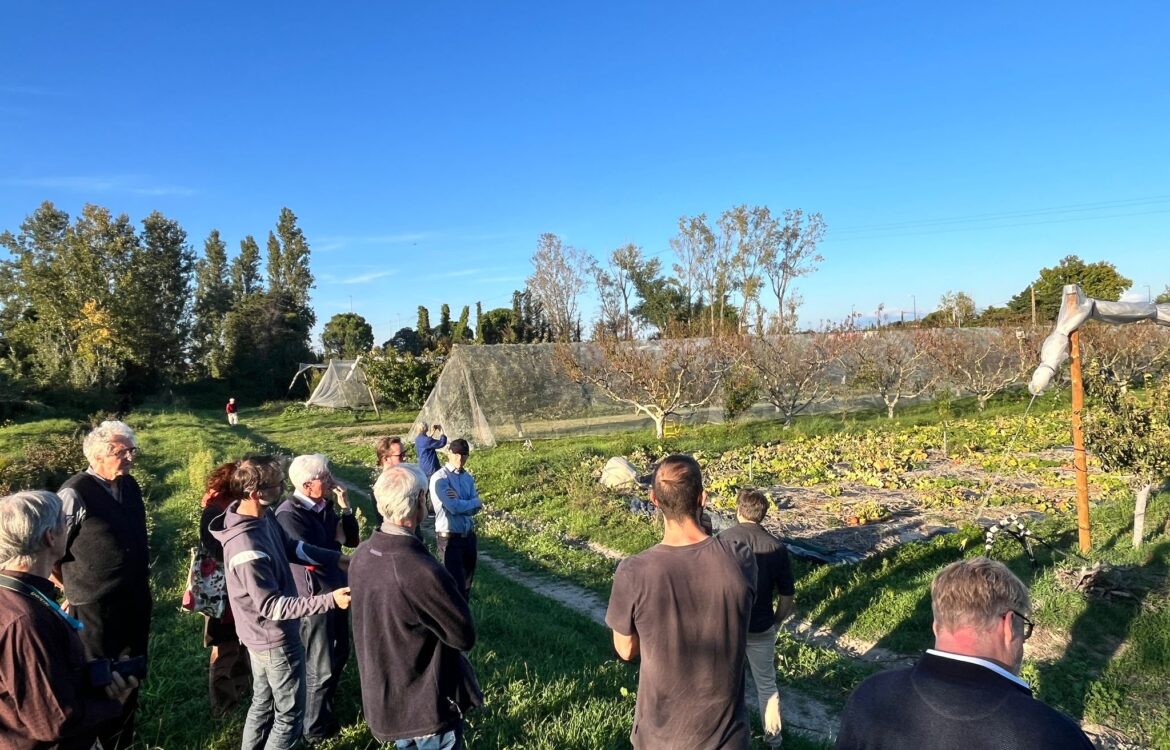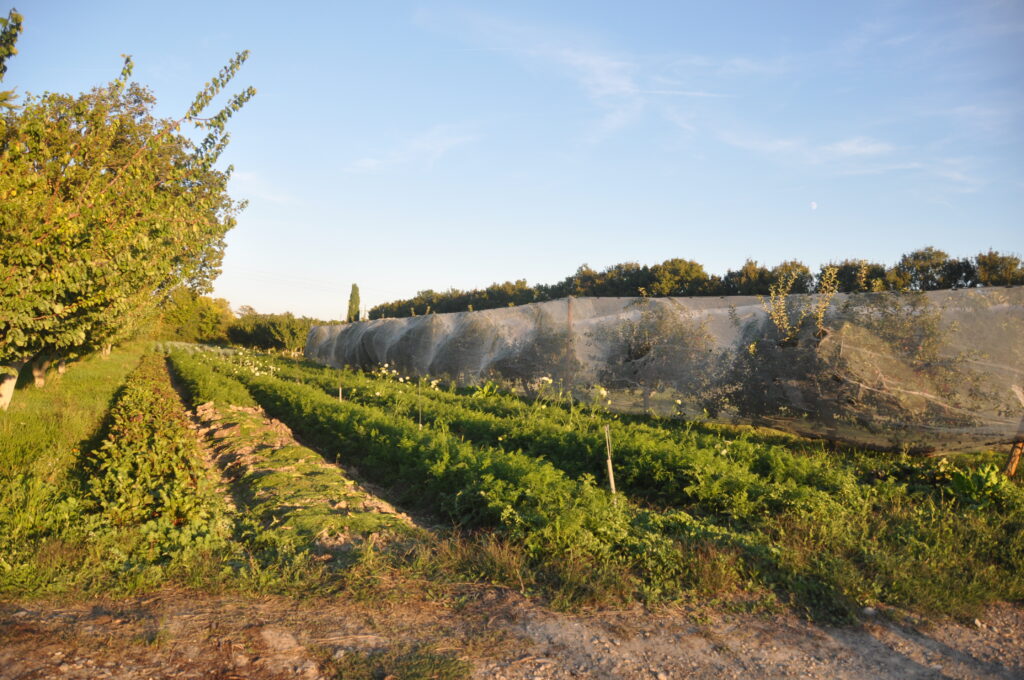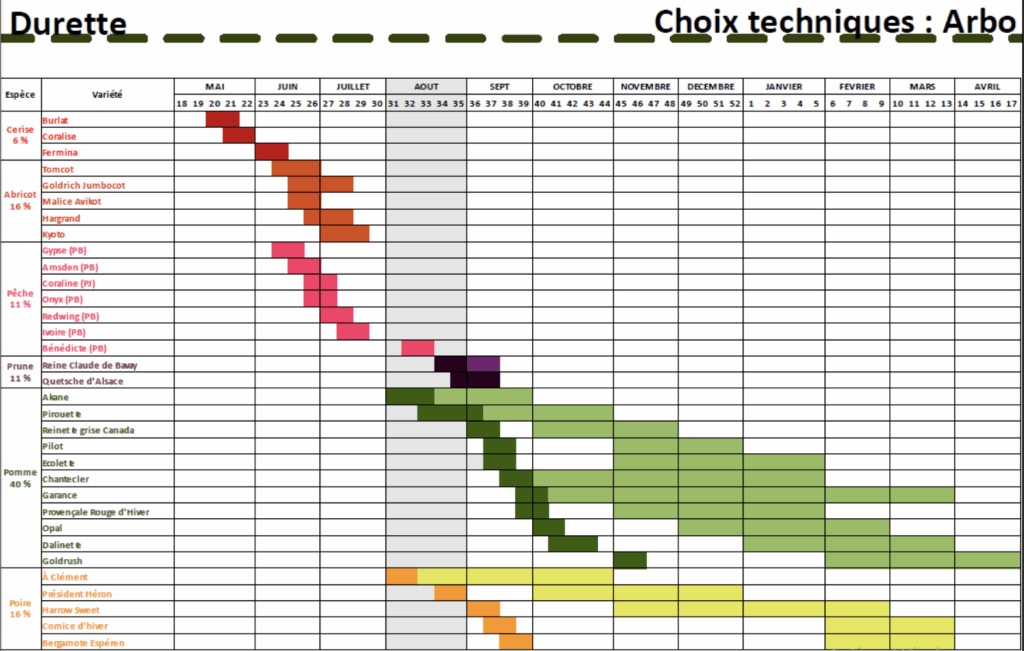
Rethinking Organic Agriculture for Tomorrow: Fruit Trees in Agroforestry
Author: Mariagiulia Mariani
Facing today’s major sustainability challenges, it has become increasingly necessary to understand the trade-offs within organic systems that aspire to serve as genuine alternatives—and to rethink them accordingly. This requires integrating agronomic advances with farmers’ socio-economic realities, adopting a systemic perspective in which technological and agronomic innovations are seen as interdependent components of a living, adaptive system.
During the third InnOBreed Annual Meeting (October 1–2, 2025), participants visited the Ferme de la Durette, a pioneering experimental farm just five minutes from INRAE—the French National Institute for Agriculture, Food and Environment—in southern Avignon. INRAE, a key project partner, hosted the meeting. InnOBreed (Innovative Organic Fruit Breeding and Uses) is a European Horizon project that strengthens the sustainability and resilience of organic fruit breeding by combining social, technical, and organizational innovation.

For over thirteen years, the Durette site has been co-managed by GRAB (Groupe de Recherche en Agriculture Biologique), another InnOBreed partner. GRAB provides advisory and technical support to farmers while monitoring agronomic practices, and socio-economic and environmental performance of this innovative system. Together ith INRAE and other complementary partners, they have turned La Durette into a long-term action research platform—a micro-AKIS (Agricultural Knowledge and Innovation System) that fosters collaborative experimentation, knowledge co-production, and adaptive learning.
Within this living laboratory, the Durette farm spans nearly four hectares and is managed by four farmers. It embodies the principles InnOBreed promotes: co-design, biodiversity, and resilience. The farm features a strong agroforestry component and remarkable diversification. Fruit trees occupy roughly half of the cultivated area, representing at least seven species with multiple cultivars per species, providing fruits from May (cherries) to March/April (late stored apples). Some cultivars were selected directly through InnOBreed’s partners work for their resilience to climate change and biotic stress (such as Garance apple variety).
The remaining cultivated land is devoted to vegetables—dominated in autumn by squash—intercropped with a rich diversity of 35–40 other organic crops. A small poultry unit complement the system, supporting nutrient cycling, pest suppression and diversified income sources.
A system rooted in biodiversity
The agroforestry system aims to reduce the use of pesticides, fungicides, and insecticides—even those allowed in organic farming—by relying on the regulating power of functional biodiversity. Its design enhances ecological interactions at multiple levels: tree species, understory crops, a small poultry unit, and associated fauna such as bats, birds, and reptiles contribute to natural pest control and ecosystem balance. For instance, alternating different fruit tree species creates natural barriers to disease spread and maintains balanced biological corridors. La Durette’s goal is to lower treatment frequency indices (IFT) by 80% compared to regional averages, harnessing functional biodiversity for ecological resilience and crop diversity for economic stability.
Beyond ecology: social and economic dimensions
Beyond environmental performance, La Durette also provides clear social benefits. Farmers report improved working conditions, such as greater comfort during summer fieldwork thanks to tree shade—benefiting both people and crops. This is not a nostalgic return to traditional farming but a modern, co-designed system, carefully planned to accommodate mechanisation, including tractor access between tree rows, while maintaining ecological balance.
Economic sustainability remains a challenge. Despite their environmental and social value, farms of this kind receive limited support from the Common Agricultural Policy (CAP), as small-scale and experimental models often face funding barriers. Currently, less than 20% of La Durette’s income comes from fruit (but trees do provide other hard-to-quantify services!), highlighting the need for careful management, long-term planning, and skilled personnel dedicated to fruit tree care. Most sales rely on short supply chains—direct marketing at the farm and collection points in nearby Avignon. La Durette thus exemplifies peri-urban agriculture, where diversified production, consumer proximity, and digital tools combine to sustain viable local markets.
Learning from practice: a co-designed system
Managing such complexity requires advanced skills in fruit tree management, continuous experimentation, and adaptive decision-making. Practices are constantly refined in response to field observations, scientific data, and collective reflection. This iterative cycle of design, implementation, and evaluation embodies the essence of ecosystem innovation, where agronomic and social dimensions evolve together.
Towards a Mediterranean agroforestry model
Agroforestry represents a promising pathway toward more sustainable, resilient, and multifunctional agriculture—economically, environmentally, and socially. The challenge now is to understand how such systems can be initiated, supported, and scaled up: what policy frameworks, financial tools, and socio-economic models are needed to make them viable across Mediterranean contexts.

Launched in June 2025 and coordinated by the University of Pisa, the PRIMA AGROFIG project aims to investigate key questions surrounding agroforestry systems across the Mediterranean basin. At the heart of the initiative is a tree that embodies both historical subsistence and future resilience: the fig tree.

